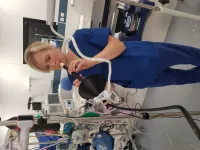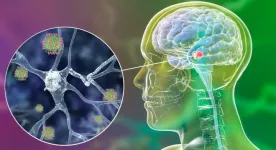(Press-News.org) Lithia, Florida -- June 29, 2021 -- Surgical resident training has traditionally occurred in a master-apprentice-type relationship, with graduated responsibilities until trainees are expected to perform procedures on their own. Given recent changes in the health care system, including reduced operating room time, increased difficulty of procedures and working hour restrictions, there is less time for residents to learn using traditional methods.
Researchers from the University of Manitoba and the Pan Am Clinic recently published a paper in the journal Arthroscopy, Sports Medicine, and Rehabilitation that looked at the effectiveness of a mixed reality simulator for the training of arthroscopy novices. Following this study, the residency program has made it a requirement in the curriculum that residents in the sports rotation complete the self-learning modules.
Dr. Samuel Larrivée, one of the study's authors, stated that "sports surgeons at our institution noted anecdotally that junior residents had difficulty reaching competency in arthroscopic skills by the end of their three-month rotation, and were not as prepared when starting their senior rotation. There was a need to increase training opportunities outside of the operating room in order to prepare our residents for independent practice."
Prior to obtaining the ArthroS™ simulator from VirtaMed, the University of Manitoba Orthopedic Surgery program occasionally used simulation such as benchtop dry simulators, cadavers and an older generation simulator with active haptics. These were mostly used to complement academic teaching sessions in small groups with some success, and available for use by residents as needed. However, due to the low fidelity and difficult setup, few residents took up the opportunity.
Medical student engagement with the ArthroS simulator was different. Alisha Beaudoin, a co-author and medical student, attested to her experience using the ArthroS simulator in her early training. "I found this training to be very helpful during my surgery rotation. Many of my preceptors were impressed by my superior arthroscopic and laparoscopic skills. This training may allow students with an interest in surgery to be more prepared."
Recently, many Canadian universities have moved to competency-based curriculums where residents must demonstrate competency prior to moving to the next defined practice level. The study noted that this is similar to the training available on ArthroS and that "a user enrolled in the mentoring program is progressed through various levels of training by meeting training targets, essentially providing a proficiency-based progression."
This paper is the first in what the authors hope is a larger body of work on validating arthroscopy simulators for resident training. There are currently plans to repeat similar studies with the other modules (hip, shoulder, and ankle), with larger sample sizes, and at different levels of training.
The Study
Study participants were divided into three groups: simulator training only, mentor-based training, and a control. At the end of four weeks, surgical performance improved among both traditional and simulator-based training groups. The study concluded that "simulator training may provide enhanced skills to improve patient safety overall, as residents may become more skilled earlier in their training, leaving more time for the mentor to teach more advanced skills." Beaudoin further explains: "I believe that simulation training should be introduced into the standardized curriculum because I believe it offers a safe space to hone your skills and improve in a stress-free environment."
Based on the study results, residents are now required to complete the self-learning modules as part of training during their sports rotation. Certain modules have been identified at the junior and senior levels. Dr. Larrivée believes this will allow residents to develop their triangulation skills and memorize the steps prior to their first surgery and consolidate their knowledge.
INFORMATION:
About Pan Am Clinic
The Pan Am Clinic is a publicly funded organization based in Winnipeg, Canada that offers a complete range of musculoskeletal care. In addition to sport medicine physicians, orthopedic surgeons, physiotherapy and day surgery services, the Clinic is affiliated with the University of Manitoba for the training of medical students, and orthopaedic surgery residents and fellows. It is also supported by the Pan Am Clinic Foundation, which helps raise funds for the Clinic's renowned research, education, and health care programs. A generous donation to the Foundation allowed the clinic to acquire the Virtamed ArthroS simulator for research and surgical training.
About VirtaMed
VirtaMed believes medical education is powerfully delivered through data-driven simulation solutions. Since 2007, we have developed the leading solutions for training outside the operating room because we believe healthcare professionals should never have to perform a procedure for the first time on a patient. VirtaMed's simulators provide the most realistic and cost-effective training available for orthopedic surgeons.
VirtaMed ArthroS is the most advanced mixed reality training simulator for diagnostic and therapeutic knee, shoulder, hip, and ankle arthroscopy. Together with AANA, AAOS, and ABOS, VirtaMed combined their virtual reality graphics with the Sawbones FAST module for Fundamentals of Arthroscopy Surgery Training. From ACL reconstruction to rotator cuff repair, VirtaMed ArthroS offers increasingly complex simulated patients and pathologies, incorporating advanced imaging techniques such as virtual fluoroscopy.
Aerosol generated by playing woodwind and brass instruments is less than that produced when vocalising (speaking and singing) and is no different than a person breathing, new research has found. The findings, published online in the journal Aerosol Science and Technology, could be crucial to developing a roadmap for lifting COVID-19 restrictions in the performing arts, which have been significantly restricted since the start of the pandemic.
The research project, known as PERFORM (ParticulatE Respiratory Matter to InForm Guidance for the Safe Distancing of PerfOrmeRs in a COVID-19 PandeMic), was supported by Public Health England, the Department for Digital, Culture, Media and Sport (DCMS), and UKRI and was carried out by a collaborative team from ...
The death of neurons specialised in the synthesis of dopamine, one of the brain's main neurotransmissors, deteriorates the motor and cognitive capacities of those with Parkinson's disease. The loss of these neurons is related to alpha-synuclein aggregation. Recent studies show that oligomers, the initial aggregates of this protein, are the most pathogenic forms of α-synuclein and are responsible for the spreading of the disease in the brain.
Therefore, one of the more promising approaches in fighting this disorder consists in neutralising these oligomers and, thus, slow down the pathological progression. ...
During the last twenty years, the trading in stock markets has undergone significant changes. Researchers from the University of Turku and the University of Palermo have investigated the role of high-frequency traders in the markets.
Technological evolution and innovations both in the technology used by stock exchanges and the resources of the traders using their services have made faster trading possible. As a result, high-frequency trading in sub millisecond scale has increased.
However, not everyone has the opportunity to use high-frequency trading, and generally, the scales can be anything from microseconds to tens of thousands of seconds. The role of high-frequency traders has given rise to broad debate over ...
HERSHEY, Pa. -- A new study by researchers at Penn State College of Medicine indicates that people living with human immunodeficiency virus (HIV) and acquired immune deficiency syndrome (AIDS) -- approximately 38 million worldwide -- are more likely to have suicidal thoughts and die from suicide than members of the general population. The researchers said that despite significant medical advancements related to HIV treatment and patients' quality of life, risk of suicide in these patients is high and health care providers should prioritize mental health screenings in this population.
According to the World Health Organization, roughly 800,000 people worldwide die from suicide annually. Among ...
Tuesday, 29 June 2021 - New research has shown that early testing for blood clots in patients who had received the AstraZeneca/Oxford vaccine led to them being treated successfully, highlighting the need for heightened awareness of the risk among doctors.
The work, led by researchers from RCSI University of Medicine and Health Sciences and the National Coagulation Centre at St James's Hospital, is published in the British Journal of Haematology.
Unusual blood clots with low blood platelets have been recognised as a very rare complication of the AstraZeneca vaccine. However, with increased awareness, ...
RUDN University chemists derived molecules that can assemble into complex structures using chlorine and bromine halogen atoms. They bind to each other as "velcro" - chlorine "sticks" to bromine, and vice versa. As a result supramolecules are assembled from individual molecules. The obtained substances will help to create supramolecules with catalytic, luminescent, conducting properties. The study is published in Mendeleev Communications.
Supramolecules are the structures made of several molecules. Individual molecules are combined, for example, by self-assembly or without external control. The resulting structure has properties that the molecules did not have individually. That is the way to create new materials, catalysts, molecular machines for ...
For the first time, scientists detected gravitational waves caused by mergers between black holes and neutron stars. Researchers from LIGO, Virgo, and KAGRA detected the two gravitational wave events--from distances of more than 900 million light-years away--within a span of 10 days in January 2020 during the second half of LIGO and Virgo's third observing run. Astrophysical Journal Letters published the results and their implications today: https://iopscience.iop.org/article/10.3847/2041-8213/ac082e.
Researchers from Rochester Institute of Technology's Center ...
The LSL60101 compound, a specific ligand of the I2-IR receptors in the brain, could shed light on the development of future strategies against Alzheimer's disease. This is stated in the recent studies by the Research Group on Medicinal Chemistry and Pharmacology of Neurodegenerative Diseases of the University of Barcelona, published in the journals European Journal of Medicinal Chemistry and British Journal Pharmacology. In studies carried out with mice, LSL60101 has improved the cognitive deficit and the biomarkers related to the disease in these animal models.
These studies result from the collaboration of the research teams led by professors Carmen Escolano, from the Faculty of Pharmacy and Food Sciences and the Institute of Biomedicine of the UB ...
Preschool children are sensitive to the gap between how much they know and how much there is to learn, according to a Rutgers University-New Brunswick study.
The research, published in the journal END ...
Under a concrete drainage culvert at the edge of a town in Botswana, a troop of banded mongoose is getting ready to leave its den. Moving from shade into light, the cat-sized animals scan the area for signs of danger and for opportunities to find something to eat in an increasingly crowded neighborhood.
Unbeknownst to them, the genetics of this troop's members -- and others like them -- are providing researchers in the College of Natural Resources and Environment with new understandings of how and why animal behavior changes in proximity to human development and how that change can impact infectious disease spread.
The researchers used genetic tools to identify changes in movement behavior among mongooses ...






